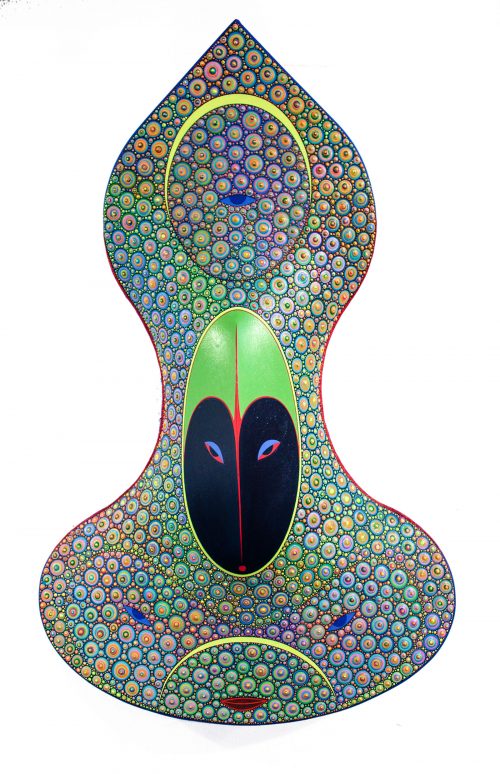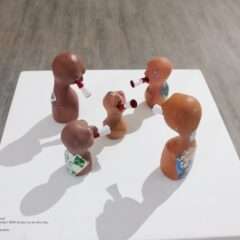
I lived just outside Philadelphia for four years, and have lived in Philly proper for almost two; in all that time, the Philadelphia equivalent of the Watts Towers (Isaiah Zagar’s Magic Gardens) had somehow managed to avoid my presence. I saw The Gardens’ hodgepodge dazzling exterior, courtyard and mirrored insides recently when I visited the exhibit by Claes Gabriel and Andrew Chalfen, Patterns of Obsession. Because of the building’s razzle dazzle, the show must compete for your attention. And yet the art acquits itself quite well in such potentially distracting surroundings.
As you enter the first gallery space, Patterns of Obsession seems to set up a fairly simple media-based divide: Claes Gabriel’s works are sculptural, figural, and totemic and Chalfen’s works are mainly paintings on panel or canvas, and abstract.
Gabriel’s often wall-mounted forms are densely patterned and brightly colored and visually echo West African masks and Pacific Northwest indigenous art, especially in his use of strong delineations between color sections and incorporations of hybrid animal forms. The artist’s sculptural shapes are organic sinuous curves, with embellishing patterns highly organized or uniform in execution. It’s not hard to see a figural element to Gabriel’s works: you can pick out half-lidded eyes, the bridge of a narrow nose, a dot of a mouth under what resembles a glorious headdress.
Chalfen’s abstract paintings burst with color and tiny, geometric forms scattered in intricate patterns, almost appearing inspired by pixelated digital art. His “Sibling in Dirt” and “Sibling in Velvet” resemble in part the zany, tightly packed compositions of Takashi Murakami. The occasional inclusion of collaged sheet music adds a note (pun intended) of regularity and stability amidst the wild, fractal color patterns that catch the eye like gems.

Acrylic on shaped canvas, 2016. Photo courtesy of Paradigm Gallery.
However, as the show continues on the opposite wall of the first gallery, this technical and media-based divide begins to appear less rigid, as if the two artists were holed up in a single studio at the same time and began to incorporate each other’s styles into their own work. The intricate concentric circles clustered together on “Queen of Time” by Gabriel are echoed in the adjacent “Soap Bubble” by Chaflen. Both artists also use flat, solid sections of color devoid of surface texture as a foil for their more patterned areas. The apotheosis of this appearance of influence comes in the form of Chalfen’s “Side 2/Side B,” which echoes Gabriel’s methods of turning simple shapes into semi-abstract figurative imagery in his masks. “Side 2/Side B” is both sculpture and painting, resembling a model of a celestial city, with small blocks of wood as skyscrapers and painted concentric circles as stars or planets floating in the sky behind them. Meanwhile, Gabriel’s “Ghost Spirit” uses flat, solid sections of color devoid of a noticeable surface texture in a way that seems anticipated by the backgrounds of Chalfen’s “Sibling in Dirt” and “Sibling in Velvet.”
Thematic similarities seem to rise to the fore with echoes of ritual and traditional forms used by cultures subject to colonization in Gabriel’s works, and remixed shapes and fragments resembling components of Aztec calendar designs in Chalfen’s painting “Imperial Response.”

The wall text for Patterns of Obsession cites the human tradition of creating patterns as a way to pass down heritage and to communicate ideas about the world around us. Gabriel’s masks are patterns that suggest faces–whether human, animal, or spirit–that depict and evoke emotional responses from the viewer. Similarly, the sheet music in several of Chalfen’s works is another type of pattern that allows us to create meaning, and to convey or pass down emotions and ideas through generations.
Oddly enough, the additional wall texts set up a dichotomy between Gabriel’s and Chalfen’s styles, calling Gabriel’s “Patterns as Culture,” and Chalfen’s, “Patterns as Rhythm.” This artificially sharp divide sells the nuances of Patterns of Obsession short. Chalfen’s inclusion of musical compositions and quasi-digital forms is not merely a type of rhythm, but a cultural artifact as well, as the notes of music and bytes of data are modes of communication across and within cultures. Similarly, the humanoid elements of Gabriel’s masks and sculptures conjure up the rhythm of life and of human continuity. Indeed, the reason we see Gabriel’s works in Patterns of Obsession as potential masks is because we recognize how two oval forms placed side-by-side above a thin, narrow shape above a dot or line implies a human face. Regardless of where in time or space we stand, this organization, or rhythm, of compositional elements has meaning to us.
In a way, staging Patterns of Obsession at the Magic Gardens makes a perfect kind of sense: the works of art collaborate with one another in unexpected ways that nonetheless manage to gel, and demonstrate active learning, just as the Magic Gardens themselves were a product of collaboration that made non-traditional objects and materials into an art experience.
[Ed note: For more on Claes Gabriel, listen to the 2011 Artblog Radio podcast interview with the artist.]
Patterns of Obsession: Claes Gabriel and Andrew Chalfen, until April 28, 2019. Conversation with the artists, April 5, 2019, 6 – 9 PM (tickets required) Magic Gardens, 1020 South st.The show is in partnership with Paradigm Gallery. See the full catalog online at Paradigm’s website.
More Photos













